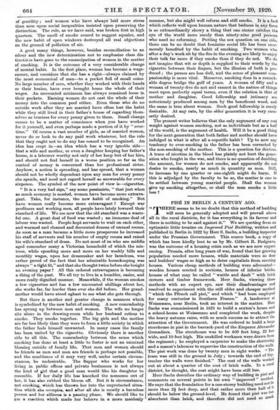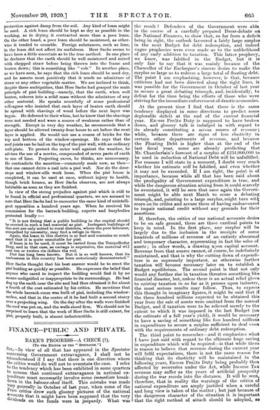PISE IN BERLIN A CENTURY AGO.
a rillIERE seems to be no doubt that this method of building will soon be generally adopted and will prevail above
all in the rural districts, for it -has everything in its favour and there is nothing to be said against it." We are quoting from an optimistio little treatise on Improved Pise Building, written and published in Berlin in 1822 by Herr S. Sada, a building inspector under the Prussian Government. This scarce book, a copy of whioh has been kindly lent to us by Mr. Gilbert R. Redgrave, was the outcome of a housing crisis such as we are now experi- encing. Prussia, after long years of war, found that her gi.ewing population needed more houses, while materials were so dear and builders' wages so high as to deter capitalists from erecting houses. Various cheap methods 'of building were advocated— wooden houses erected in sections, houses of inferior
.houses of what may be called "wattle and daub." With trick corners and timber framework. Herr Sachs, viewing then methods with an expert eye, saw their disadvantages and resolved to experiment with the still older and cheaper method "which the French call pise," and which "had been employed for many centuries' in Southern France." A landowner at Weissensee, near Berlin, took an interest in the matter. Herr Sachs was commissioned in 1821 to build a sexton's house, and a school-house at Weissensee and completed the work, despite the heavy autumn rains, with so much success as to attract the attention of the Government. He was ordered to build a large storehouse in pine in the barrack-yard of the Emperor Alexander Grenadiers. The storehouse was to be 400 feet long, 22 feet wide, and 10 feet high. His unskilled workmen were drawn from the regiment ; he employed a carpenter to make the shuttering and a mason's labourer to supervise the construction of the wan. The pith work was done by twenty men in eight weeks. 4, The loam was still in the ground in July ; towards the end of Sep- tember the walls were finished." The cost of the walls worked out at about a quarter of the coat of brick walls. In a rural district, he thought, the cost might have been still less. Herr Sachs describes the ordinary way of building in pig and comments on several point; in his own " improved " method. He says that the foundation for a one-storey building need not be more than 2i feet deep, and that rather more than half of it should be below the ground-level. He found that pine was lees 'absorbent than brick, and therefore did not need so ulna protection against damp from the soil. Any kind of loam might be used. A rich loam should be kept as dry as possible in the working, as in drying it contracted more than a poor loam. On the other hand, a poor loam should be moistened, as other- wise it tended to crumble. Foreign substances, such as lime, in the loam did not affect its usefulness. Herr Sachs seems to have been a little uncertain as to the true method. In one place he declares that the earth should be well moistened and mixed with chopped straw before being thrown into the frame and beaten down; this is something like " cob." In another place,• as we have seen, he says that the rich loam should be used dry, and he assorts most positively that it needs no admixture of straw or any other vegetable matter. We are inclined to think, despite these ambiguities, that Herr Sachs had grasped the main principle of pig building—namely, that the earth, when well beaten, coheres into a solid mass without the admixture of any other material. He speaks scornfully of some professional colleagues who insisted that each layer of beaten earth should be spread with shavings of wood before the next layer was begun. He deferred to their whim, but he know that the shavings were not needed and were a source of weakness rather than of strength. Except in very dry weather, he recommends that a layer should be allowed twenty-four hours to set before the next layer is applied. He would not use a course of bricks for the top and bottom of the window-openings. He says that the roof-joists can be laid on the top of the pied wall, with an ordinary wall-plate. To protect the outer wall against the weather, he advises the use of a mortar, compounded of seven parts of earth to one of lime. Projecting eaves, he thinks, are unnecessary. He contradicts the assertion—commonly made now, as then— that one cannot drive a nail into a pig wall. Nor do the door- steps and window-sills work loose. When the pied house is completed, it can be used at once, without injury to health, though brick houses, as Herr Sachs observes, are not always habitable as soon as they are finished.
In view of the strong prejudice against pied which is still to be found in official and professional quarters, we are amused to note that Herr Sachs had to encounter the same kind of unintelli- gent opposition a hundred years ago. When he received his commission for the barrack-building, experts and busybodies protested loudly :—
'it is not fitting that a public building in the capital should be erected in such a bad material as pied. Inelegant buildings of des sort are only suited to rural districts, where the poor labourer, compelled by necessity, may find a refuge in them. Again, therloam in this district is so bad and contains so much sand that it is quite unsuitable for pise. If loam is to be used, it must be carted from the Tempelhofer Berg, and in that case, as cartage is expensive, the material will cost ten or twelve rix-dollars the rod.
rise has long been known. But it is so well known, that its Uselessness in this country has been notoriously demonstrated."
Herr Sachs thought that his best answer would be to erect the pied buiding as quickly as possible. He expresses the belief that anyone who cared to inspect the building would find it by no means undignified or inappropriate to its surroundings. He had dug up the earth near the site and had thus obtained it for about S fourth of the cost estimated by his critics. He mentions that the whole barrack-room was built of OA including the window- arches, and that in the centre of it he had built a second storey over a projecting wing. On the day after the walls were finished the roof was put on, and the walls stood firm. We should not be surprised to learn that the work of Herr Sachs is still extant, for pise, properly built, is almost indestructible.



































 Previous page
Previous page